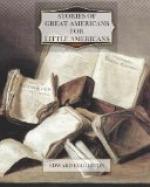Penn took up the great paper from the ground. He handed it to the great chief that wore the horn on his head. He told the Indians to keep it and hand it to their children’s children, that they might know what he had said. Then he gave them many presents of such things as they liked. They gave Penn a name in their own language. They named him “O-nas.” That was their word for a feather. As the white people used a pen made out of a quill or feather, they called a pen “o-nas.” That is why they called William Penn “Brother O-nas.”
Penn sometimes went to see the Indians. He talked to them, and gave them friendly advice. Once he saw some of them jumping. They were trying to see who could jump the farthest.
Penn had been a very active boy. He knew how to jump very well. He went to the place where the Indians were jumping. He jumped farther than any of them.
When the great gov-ern-or took part in their sport, the Indians were pleased. They loved Brother O-nas more than ever.
ONE LITTLE BAG OF RICE
The first white people that came to this country hardly knew how to get their living here. They did not know what would grow best in this country.
Many of the white people learned to hunt. All the land was covered with trees. In the woods were many animals whose flesh was good to eat. There were deer, and bears, and great shaggy buf-fa-loes. There were rabbits and squirrels. And there were many kinds of birds. The hunters shot wild ducks, wild turkeys, wild geese, and pigeons. The people also caught many fishes out of the rivers.
Then there were animals with fur on their backs. The people killed these and sold their skins. In this way many made their living.
Other people spent their time in cutting down the trees. They sawed the trees into timbers and boards. Some of it they split into staves to make barrels. They sent the staves and other sorts of timber to other countries to be sold. In South Car-o-li-na men made tar and pitch out of the pine trees.
But there was a wise man in South Car-o-li-na. He was one of those men that find out better ways of doing. His name was Thomas Smith.
Thomas Smith had once lived in a large island thousands of miles away from South Car-o-li-na. In that island he had seen the people raising rice. He saw that it was planted in wet ground. He said that he would like to try it in South Car-o-li-na. But he could not get any seed rice to plant. The rice that people eat is not fit to sow.
One day a ship came to Charles-ton, where Thomas Smith lived. It had been driven there by storms. The ship came from the large island where Smith had seen rice grow. The captain of this ship was an old friend of Smith.
The two old friends met once more. Thomas Smith told the captain that he wanted some rice for seed. The captain called the cook of his ship, and asked him if he had any. The cook had one little bag of seed rice. The captain gave this to his friend.




